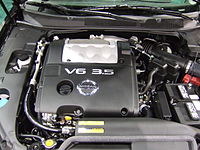Nissan VQ engine
The VQ is a family of V6 automobile petrol engines developed by Nissan and produced in displacements varying from 2.0 L to 4.0 L. Designed to replace the VG series, the all-aluminium 4-valve per cylinder DOHC design debuted with Nissan's EGI/ECCS sequential multi-point fuel injection (MPFI) system.
Later versions featured various improvements, such as variable valve timing, and NEO-Di designated VQ engines replace MPFI with direct fuel injection.
It is fitted to the following vehicles: The VQ23DE displaces 2.3 L (2349 cc) and is eqontinuously Variable-valve Timing Control).
It is an aluminium open deck block design with microfinished internals and a relatively light weight.
The engine was used in the 2000–2001 Nissan Maxima and adds a true dual-runner intake manifold for better high-end performance compared to some earlier Japanese and Middle-East market versions of this engine (2000-2001 Infiniti I30 models added an additional fenderwell intake, boosting power to 230 PS (227 hp; 169 kW)).
It is fitted to the following vehicles: The twin-turbo VQ30DETT is an engine used only in Nissan's race cars, primarily in the Super GT (formerly the JGTC).
It uses a similar block design to the VQ30DE, but adds variable valve timing (CVTCS) for the intake.
It included variable exhaust timing, a higher rev limit, and a revised oil pump, boosting the output to 297 crank horsepower.
A modified version of the VQ35DE, called the S1, is produced by Nismo (Nissan's motorsports and performance division) for the Fairlady Z S-Tune GT.
Compression ratio is 9.7:1 Improvements include continuously variable valve timing, variable length/volume intake system, silent timing chain, hollow and lighter camshafts and friction reduction (microfinished surfaces, moly coated pistons).
It is fitted to the following vehicles: The VQ35HR engine was first seen in the US with the introduction of the updated 2007 G35 Sedan model, which debuted in August 2006.
As of 2009, the Infiniti EX35 produces 297 hp (221 kW; 301 PS) and the same torque presumably due to tighter regulations.
The electrically actuated variable valve timing on the exhaust cams to broaden the torque curve is new over the "DE" engine.
The VQ35HR was utilized in rear-wheel-drive platforms while the VQ35DE continued to power Nissan's front-wheel-drive vehicles.
In 2010, Nissan introduced a hybrid version of the VQ35HR, pairing the engine to a lithium-ion battery pack.
By 2007, Nissan's ambition to increase the competitiveness of the Z33 chassis in Super Taikyu racing resulted in the development of a larger displacement engine based on the original VQ35HR Block.
The end result was the VQ38HR powered Nismo Type 380RS-C which went on to dominate ST class 1 racing.
The engine displacement remains the same, while the intake manifold and exhaust, air-fuel ratio, ignition timing, VTC and other specs have been optimized for street use.
[3] The VQ38HR fitted to the following vehicles: The VQ35HR and VQ25HR engines were built at Nissan's Iwaki Plant in Fukushima Prefecture.










